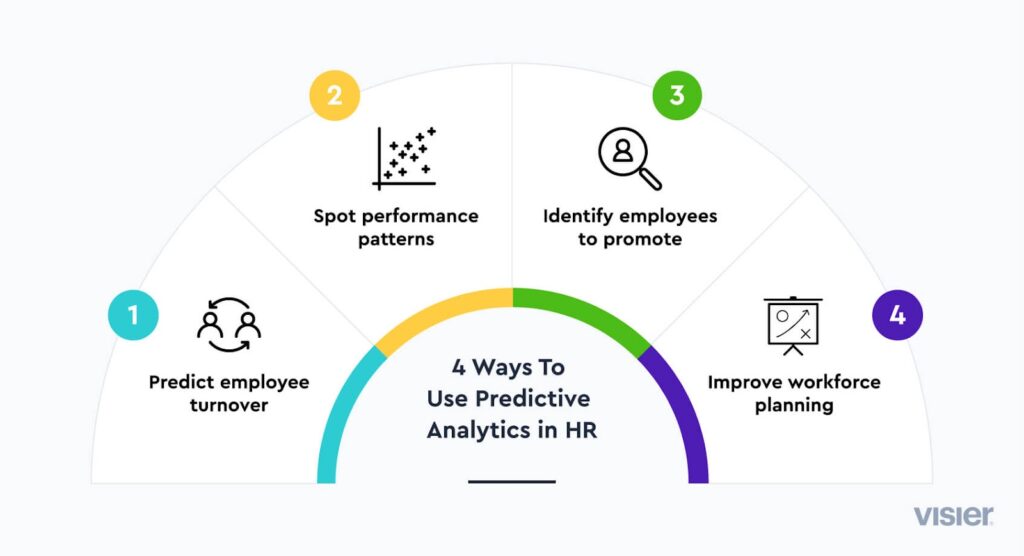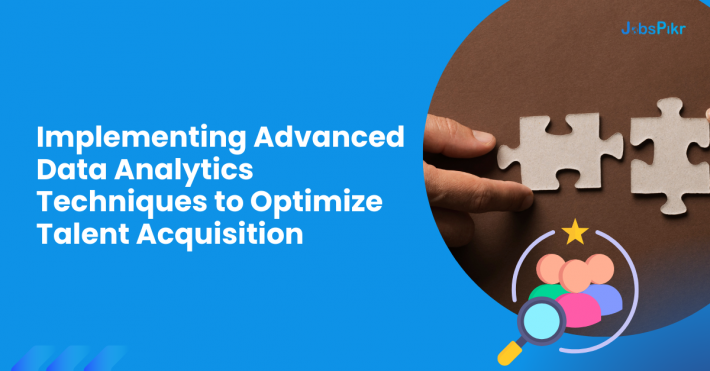Businesses are constantly seeking innovative ways to enhance their talent acquisition strategies during this competitive job market. The integration of advanced data analytics techniques into the recruitment process is revolutionizing how companies identify, attract, and retain top talent. By leveraging predictive analytics and machine learning models, organizations can significantly improve hiring outcomes. This article explores the implementation of advanced data analytics techniques in talent acquisition, offering insights into how these technologies can transform the recruitment landscape.

Source: Visier
The Role of Advanced Data Analytics in Talent Acquisition
Advanced data analytics techniques encompass a range of tools and methodologies designed to analyze vast amounts of data and extract actionable insights. In the context of talent acquisition, these techniques help recruiters make informed decisions by predicting candidate success, optimizing job postings, and streamlining the hiring process.
Predictive Analytics in Talent Acquisition
Predictive analytics involves using historical data and statistical algorithms to forecast future outcomes. In talent acquisition, predictive analytics can be employed to identify patterns and trends that indicate a candidate’s potential success within a company. By analyzing past hiring data, recruiters can develop models that predict which candidates are most likely to excel in specific roles.
- Identifying Top Candidates
One of the primary applications of predictive analytics is identifying top candidates. By analyzing data from previous hires, such as their education, work experience, skill gap, and performance metrics, predictive models can highlight the characteristics of successful employees. Recruiters can then use these models to evaluate new applicants, focusing their efforts on individuals who possess similar attributes.
- Reducing Employee Turnover
Predictive analytics can also help reduce employee turnover by identifying candidates who are more likely to stay with the company long-term. By analyzing factors such as job satisfaction, engagement levels, and previous employment history, organizations can develop profiles of candidates who are likely to be a good cultural fit and have a higher retention rate.
Machine Learning Models in Talent Acquisition
Machine learning, a subset of artificial intelligence, involves training algorithms to learn from data and make predictions or decisions without being explicitly programmed. In talent acquisition, machine learning models can automate and enhance various aspects of the recruitment process.
- Resume Screening
One of the most time-consuming tasks for recruiters is screening resumes. Machine learning models can automate this process by analyzing resumes and identifying candidates who meet the required qualifications. Natural language processing (NLP) algorithms can extract relevant information from resumes, such as skills, experience, and education, and match it against job descriptions. This not only saves time but also ensures a more objective and consistent evaluation of candidates.
- Candidate Matching
Machine learning models can also improve candidate matching by analyzing both candidate profiles and job descriptions. These models can identify the best-fit candidates for a role by considering various factors, such as skills, experience, and cultural fit. By leveraging these insights, recruiters can make more informed decisions and reduce the time-to-hire.
Implementing Advanced Data Analytics Techniques
Implementing advanced data analytics techniques in talent acquisition requires a strategic approach. Here are some key steps to consider:
- Data Collection and Integration
The first step in implementing advanced data analytics techniques is to collect and integrate data from various sources. This includes candidate resumes, job descriptions, performance reviews, and other relevant data points. Organizations should ensure that they have a robust data infrastructure in place to support the storage, processing, and analysis of this data.
- Building Predictive Models
Once the data is collected, the next step is to build predictive models. This involves selecting the appropriate algorithms and training them on historical data. It’s important to continuously refine these models by incorporating new data and feedback from the recruitment process. This iterative approach ensures that the models remain accurate and relevant over time.
- Leveraging Machine Learning Tools
There are several machine learning tools and platforms available that can facilitate the implementation of advanced data analytics techniques. These tools provide pre-built algorithms and frameworks that can be customized to meet the specific needs of the organization. Leveraging these tools can accelerate the implementation process and ensure that the models are scalable and efficient.
- Continuous Monitoring and Improvement
Implementing advanced data analytics techniques is an ongoing process. Organizations should continuously monitor the performance of their predictive models and machine learning algorithms. This involves tracking key metrics, such as time-to-hire, quality of hire, and employee retention rates. By regularly reviewing these metrics, recruiters can identify areas for improvement and make necessary adjustments to their strategies.
Benefits of Advanced Data Analytics Techniques in Talent Acquisition
The implementation of advanced data analytics techniques in talent acquisition offers several benefits:
- Improved Hiring Outcomes
By leveraging predictive analytics and machine learning models, organizations can significantly improve their hiring outcomes. These techniques enable recruiters to identify top candidates, reduce employee turnover, and make more informed decisions. As a result, companies can build high-performing teams and achieve better business outcomes.
- Enhanced Efficiency
Advanced data analytics techniques automate various aspects of the recruitment process, such as resume screening and candidate matching. This not only saves time but also ensures a more objective and consistent evaluation of candidates. Recruiters can focus their efforts on high-value tasks, such as engaging with candidates and building relationships.
- Data-Driven Decision Making
Data-driven decision making is a key advantage of implementing advanced data analytics techniques. By leveraging data analytics, recruiters can make more informed decisions based on evidence rather than intuition. This leads to more accurate and effective hiring strategies.
- Competitive Advantage
In today’s competitive job market, organizations that leverage advanced data analytics techniques gain a competitive advantage. By optimizing their talent acquisition strategies, companies can attract and retain top talent, improve employee performance, and achieve better business outcomes. This ultimately positions them as leaders in their industry.
Conclusion
Implementing advanced data analytics techniques in talent acquisition is transforming how organizations identify, attract, and retain top talent. By leveraging predictive analytics and machine learning models, companies can significantly improve their hiring outcomes, enhance efficiency, and make data-driven decisions.
As the job market continues to evolve, the integration of advanced data analytics techniques will become increasingly essential for organizations looking to gain a competitive advantage and build high-performing teams. Embracing these technologies is not just an option but a necessity for the future of talent acquisition.Explore how our JobsPikr can help your organization thrive: Sign Up Now or Contact Us today.



